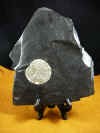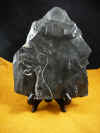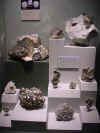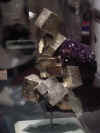You Are On: Rocks & Minerals Page 5
Click To Go To:
Rocks & Minerals Page 1 Page 2 Page 3 Page 4 Page 5 Page 6 Page 7 Page 8 Page 9 Page 10 Page 11 Page 12
TABLE OF CONTENTS ON PAGE 1
Contents: Magnetite Sand; Aluminum .999 ingots; Pyrite specimens from Peru, Pyrite suns from Illinois; Desert Roses, Picture Jasper, Septarian Nodule slice Specimens; Mimetolith links
MAGNETITE (pure, genuine)
from CONFEDERATE GOLD MINE
A working gold mine located in South Carolina
Magnetic black sand byproduct from gold mining
Magnetite is a mineral and one of the main iron ores.
With the chemical formula is Fe3O4, it is one of the oxides of iron.
Magnetite is ferrimagnetic; it is attracted to a magnet and can be
magnetized to become apermanent magnet itself.
It is the most magnetic of all the naturally-occurring minerals on Earth.
Small grains of magnetite occur in almost all igneous and metamorphic rocks.
Magnetite is black or brownish-black with a metallic luster,
has a Mohs hardness of 5–6 and leaves a black streak.
The chemical IUPAC name is iron(II,III) oxide
and the common chemical name is ferrous-ferric oxide.
  

METAPHYSICAL PROPERTIES:
Magnetite has a deep positive vibration, with a magnetic attraction to help you bring into your life what you most want.
This is a strong spiritual grounding stone that works by grounding you, down through the base chakra to the earth star chakra and Mother Gaia.
The magnetic qualities of this stone allow you to have a more balanced view of life, so it may aid emotional problems, and it is an excellent stone to use if you are on
the spiritual path.
Use it in meditation, as it is most helpful to assist you to enter the deeper meditative states.
Your connection with Mother Gaia, and a deeper appreciation of the planet will happen naturally and easily at this time.
It is a strong psychic protection stone.
|

#R500-1
Glass vial, twist top with Confederate Mining Company logo is 2-1/2" tall x 1/2" diameter; Weight: 1 ounce
$9
|

#R500-2
Plastic with snap-on plastic cap with Confederate Mining Company logo; Weight: 3 ounces
$18
|

#R500-3
The Big Kahuna. If you work with magnetite as a healer, this is the best deal of all.
A full SIX POUNDS (96 ounces) in this plastic jar, twist cap, with Confederate Mining Company logo
(3 available)
$69
|
ALUMINUM .999 INGOTS
from the Confederate Mine in Abbeville, SC
The only gold mine in South Carolina |
.JPG)
.JPG) .JPG) .JPG) .JPG)
#R501-1
Stamped: Confederate Mine, S.C. Abbeville
2903 grams; AL .999,
and the Confederate Mine circular logo under the word Abbeville.
Measures 8-1/4” long x 4-3/8” wide x 2-1/4” tall
Weight: 6 pounds 6 ounces
$65 SOLD |
.JPG)
.JPG) .JPG) .JPG) .JPG)
#R501-2
Stamped: Confederate Mining Co., S.C.
2803 grams, .999 AL,
and the Confederate Mine circular logo on bottom
Measures 8-1/4” long x 4-1/8” wide x 3” tall
Weight: 6 pounds 3 ounces
$65 SOLD |
Natural PYRITE SUN in ANTHRACITE COAL SHALE MATRIX
Always hard to believe, but this is the way the pyrite suns naturally form, and then are mined out of the coal mine in Sparta, Illinois. This is a high quality, shiny, dense shale found between the coal seams, in which just the right minerals, pressure, heat and water combine to grow the pyrite sun as you see here. You will receive exactly what you see in the photo.
Pyrite suns (also known as "fool's gold") were thought to be fossilized sand dollars or lily pads, when in fact they are pyrite crystals formed between layers of slate and coal, found deep in coal mines in Sparta (Randolph County), IL, 300 million years ago. A very difficult cleaning process unveils their hidden natural beauty. As the Illinois coal mines shut down one by one, these specimens will become more and more rare.
  
This is a close up of the pyrite sun, and of the back.
You will see drill bit marks in some of the shale matrix, these are not fossils but drill marks separating the shale.
Chemistry: Iron sulfide
Class: Sulfides, Color: brass yellow; Luster: metallic
Transparence: Opaque; Fracture: none/conchoidal;
Crystal system: Isometric; Moh's hardness: 6-6.5
Locality: Sparta, Randolph County, Illinois
Individually priced
|
 
R541-6
BLUE-GREEN
12-7/8" long x 7-7/8" wide x 1-1/4" thickest
Pyrite sun 3-5/8" diameter
4 lbs 13 oz
|
|
Pyrite Suns
(IRIDESCENT RAINBOW COLORS)
Iridescent pyrite suns are caused by exposure to chemical gases possibly chlorine which occurs naturally to get the beautiful iridescent color, making it look like a sun or sun rise.
|
|
EXTRA-LARGE
3-1/2 to 4-1/4"
|

#R-543-120 4-1/4" $38 SOLD
|
|
Did you know? That Black Jet, made popular in turquoise jewelry, is actually a type of fossilized WOOD turned to COAL, formed 180 million years ago from dead trees? TRUE. |
DESERT ROSES
From Naica, Chihuahua, Mexico. Found in a mine cavern are these glassy gypsum formations called "selenite". Crystals grow as opaque sand-filled crystal clusters with mica-like sheets. Clusters can be HUGE (room-sized) or just single ball rosettes. Under shortwave UV light, they fluoresce a bright cream color and are moderately phosphorescent, a good customer named Mike reports. Thanks, Mike! Gotta have one?
|
 |
#R-560 5-1/2 x 3 x 3" tall, large roses, nice display |
$25
|
 |
#R-562 8 x 5 x 4" tall, small roses, beautiful display piece |
$65
|
SEPTARIAN NODULE specimens
Septarian nodules are found 15 miles E of Zion National Park, Utah. They were formed in an ancient sea floor during the Cretaceous period, 50-70 million years ago when the Gulf of Mexico extended into Utah. On the ocean floor, mud formed around decomposed sea life. Rocking back and forth in the water caused mud balls. When the ocean receded, the mud balls dried and cracked open.
Over the eons to follow, mineralized solutions deposited in the cracks. First forming brown ARAGONITE, then golden CALCITE and occasionally BARITE clusters were formed within the cavities. The outside of the mud ball is now a gray limestone rock. As the nodules weathered out of the gray clay hills, at one time they could be picked up by hand on the surface. Now, excavating equipment is required for extraction, 20-40 feet underground.
The name "Septarian" is Latin "Septem" meaning seven. The mud balls cracked with seven points in every direction, creating a beautiful design. The fossil which started forming the Septarian nodule is sometimes noticeable in the rock. So, yellow center = Calcite, Brown lines = Aragonite, Gray rock = Limestone.
One side polished to a high sheen; these work well as coasters for the coffee table, or lovely display pieces
Priced as marked; average 1/2" thick slabs
|
|
|
.JPG) .JPG)
#R591-2
5-3/8” diameter
Weight: 1 pound 4.3 ounces
$42
|
.JPG) .JPG)
#R591-3
5-1/8” diameter
Weight: 1 pound 3.9 ounces
$42
|
.JPG) .JPG)
#R591-4
5-1/8” diameter
Weight: 14.9 ounces
$42
|
.JPG) .JPG)
#R591-6
5-3/4” diameter
Weight: 1 pound 2.5 ounces
$46 |
.JPG) .JPG)
#R591-7
5-3/4” diameter
Weight: 1 pound 1 ounce
$46 |
.JPG) .JPG)
#R591-10
6-3/8” diameter
Weight: 1 pound 5.7 ounces
$56
|
.JPG) .JPG)
#R591-11
6-3/8” diameter
Weight: 1 pound 5.1 ounces
$56
|
.JPG) .JPG)
#R591-12
6-1/8” diameter
Weight: 1 pound 7.8 ounces
$56
|
.JPG) .JPG)
#R591-13
6” diameter
Weight: 1 pound 7.6 ounces
$56
|
 
Awesome fish carving in Septarian nodule material. (seen front and back). 9 1/2" long x 7 1/2" high. (3 1/4 pounds).
This is Glenn's personal treasure, not for sale.
|
|
MIMETOLITHS
Cool Customer Kristal shared photos with us of his great collection of mimetoliths (a natural topographic feature, rock outcrop, rock specimen, mineral specimen, or loose stone the shape of which resembles something else).
Let your curiosity take you to searching the net using the word "mimetolith", you will find some amazing formations, it can be addictive. here's one example:
cst.cmich.edu
My most recent experience would be in the Kartchner Caves in Arizona, where there were bacon, eggs and angel formations within the cave which were mind boggling (see Latest Travels, for November 2007 for photos).
Our neighbor Rebecca came across this tree stump that beavers had gnawed into what looks like an elephant head. See what you think:

|
Click To Go To:
Rocks & Minerals Page 1 Page 2 Page 3 Page 4 Page 5 Page 6 Page 7 Page 8 Page 9 Page 10 Page 11 Page 12
TABLE OF CONTENTS ON PAGE 1









.JPG)
.JPG)
.JPG)
.JPG)
.JPG)
.JPG)
.JPG)
.JPG)
.JPG)
.JPG)



























.JPG)
.JPG)
.JPG)
.JPG)
.JPG)
.JPG)
.JPG)
.JPG)
.JPG)
.JPG)
.JPG)
.JPG)
.JPG)
.JPG)
.JPG)
.JPG)
.JPG)
.JPG)


